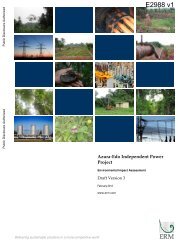Study of Small and Medium Enterprises in Azerbaijan - IFC
Study of Small and Medium Enterprises in Azerbaijan - IFC
Study of Small and Medium Enterprises in Azerbaijan - IFC
Create successful ePaper yourself
Turn your PDF publications into a flip-book with our unique Google optimized e-Paper software.
5.2 Permits coverage<br />
The <strong>Azerbaijan</strong>i legislation does not clearly specify the number <strong>of</strong> government agencies<br />
entitled to issue permits, nor does it provide for the list <strong>of</strong> permits needed to carry<br />
out a bus<strong>in</strong>ess. As a result, government agencies can <strong>in</strong>troduce permits sometimes<br />
<strong>in</strong>dependently <strong>and</strong> accord<strong>in</strong>g to specific requirements. This leads to wide coverage<br />
<strong>of</strong> activities subject to permits, differentiated issuance procedures, different cost for<br />
issued permits <strong>and</strong> variable time periods for application review.<br />
Accord<strong>in</strong>g to the survey results, <strong>of</strong> the total <strong>of</strong> all the entrepreneurs who needed to<br />
obta<strong>in</strong> a permit <strong>in</strong> 2007 (81 percent <strong>of</strong> the total), 23 percent <strong>of</strong> <strong>in</strong>dividual entrepreneurs<br />
<strong>and</strong> 17 percent <strong>of</strong> SMEs required it for the start-up purposes (see Chart 5.1).<br />
This means that permits are needed not only to start a bus<strong>in</strong>ess, but also to cont<strong>in</strong>ue<br />
activity. S<strong>in</strong>ce entrepreneurs are vulnerable if the permit is not issued or renewed, the<br />
permits issuance process opens the door for un<strong>of</strong>ficial ways to solve issues <strong>and</strong> results<br />
<strong>in</strong> higher expenditure (see also section 5.4).<br />
Chart 5.1<br />
The percentage<br />
<strong>of</strong> entrepreneurs<br />
needed permit <strong>in</strong><br />
2007<br />
(% <strong>of</strong> respondents)<br />
30%<br />
25%<br />
20%<br />
15%<br />
23%<br />
17%<br />
10%<br />
5%<br />
0%<br />
Individual entrepreneurs<br />
SMEs<br />
Accord<strong>in</strong>g to survey results, the M<strong>in</strong>istry for Emergency Affairs, the M<strong>in</strong>istry <strong>of</strong> Taxes,<br />
<strong>and</strong> the M<strong>in</strong>istry <strong>of</strong> Labor <strong>and</strong> Social Protection cover the large majority <strong>of</strong> permits<br />
(see Chart 5.2).<br />
Many normative legal acts that regulate the issuance <strong>of</strong> permits sometimes are not<br />
thoroughly exam<strong>in</strong>ed. There are many cases <strong>in</strong> which different government agencies<br />
dem<strong>and</strong> double requirements from entrepreneurs. Double regulation is observed <strong>in</strong><br />
the form <strong>of</strong> “certification + permit issuance”. This requirement forces entrepreneurs to<br />
obta<strong>in</strong> a permit for the action or product which that has already undergone the certification<br />
procedure. In these cases, one agency could take over both <strong>of</strong> these <strong>in</strong>structions.<br />
The Law on Foodstuff 33 is a vivid example <strong>of</strong> double requirements (see Box 5.3).<br />
33<br />
The Law on Foodstuff, dated November, 18 1999, No. 759.<br />
Aze r b a i j a n Bu s i n e s s En a b l i n g En v i r o n m e n t Pr o j e c t 77

















